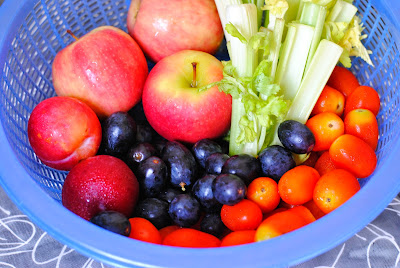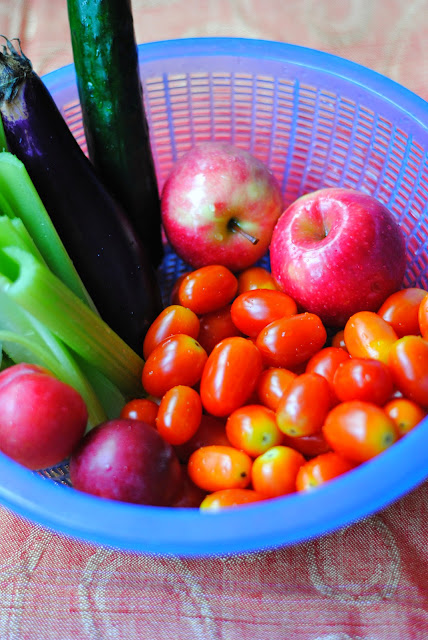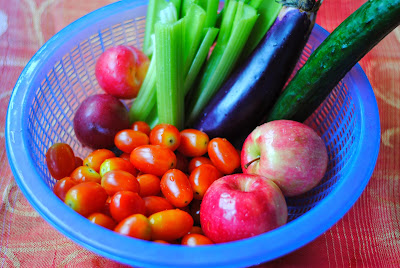We love
udon meals, especially on cold nights. Hot udon soup reminds me on Lunar New Year's steamboat in simplified form. Although udon (うどん) -- thick wheat floor noodle -- originates from Japan, I used Made in Korea udon for this recipe, simply because the brand was on promotion at NTUC Fairprice today.

Udon has soft, slight chewy texture and slight salty taste. In term of diameter, udon is thicker than thick rice noodle (粗米粉) commonly used for
laksa in Singapore. Udon is also similar to
pici / pinci, which is fat spaghetti originating from Sienna, Tuscany, Italy.
We prefer to have our no-fry udon in dried form to soup-based one, with a bowl of hot soup rich in ingredients as a companion. This preference is because dried seasoned udon is more fragrant and less scalding than the soup-based one, especially for toddlers' relatively sensitive tongues.
Udon soups are often served with delicious crispy tempura or fried tofu, but tonight I am preparing no fried meal. This recipe is a good choice when we or a family member suffers from sore throats, cough (
please pray me to recover quickly from cough that has waken me up at nights), or flu.
Servings: 1 adult + 1 child
Preparation and cooking time: 20 minutes*
* You can do faster because I took my own sweet time, and wash some utensils in between preparation.
Ingredients:
♥ 1 packet fresh udon noodles (
乌冬面)
♥ 1 cup lettuce (
生菜)
♥ 1 cup baby spinach (
菠菜)
♥ 1 cup green bok choy (
小白菜)
♥ 1 tomato (
番茄), quartered
♥ 1 egg (
鸡蛋)
♥ 3 imitation crab meat sticks (
kepiting imitasi), cut into inches long
♥ 1 tbsp anchovies (
ikan teri)
♥ 1 tsp sesame oil (
麻油)
♥ 1 tbsp honey (
madu)
♥ 1 tbsp fresh cilantro / coriander (
daun ketumbar), finely chopped
♥ 1 clove garlic (
bawang putih), pressed
Directions:
1. Boil water with anchovies to let flavor out.
2. Meanwhile, wash vegetables thoroughly.
3. Add tomatoes, crab sticks, and later vegetables to boiling water.
4. After vegetables are cooked, add egg to soup and quickly stir to obtain soft tofu-like texture for 1 minute.
5. Pour soup into bowls.
6. Boil water to cook udon for 2 minutes or until the noodles are separated.
7. Meanwhile, make seasoning by mixing sesame oil, honey, cilantro and garlic.
8. Drain cooked udon noodles and coat them with seasoning by gently tossing them.
Tips:
♥ Use pre-made
soup stock (if any) to replace water for soup.
♥ For variations, substitute anchovies with miso (fermented soy bean paste). Jaden Hair at Steamy Kitchen shared that to
dissolve miso, whisk it in a separate bowl with parts of hot soup before adding the mixture back to saucepan. Directly adding undissolved miso to saucepan may cause the miso to turn gritty. However, Marc Matsumoto at
No Recipes appears to
disagree with this. For me, I simply try whatever methods that work.
Other recipes that I love:
♥ Namiko Chen's
kitsune udon with aburaage** at Just One Cookbook
♥ Bon Appétit Test Kitchen's
udon noodle soup with vegetables
♥ Katie's
veggie miso udon soup at Produce on Parade
**
Aburaage (deep-fried tofu) sweetly reminds me on
tau pok (fried tofu) of Singapore, a favorite food of baby Ren's Dad.
For faster-to-prepare recipes, consider our
#5minutemeal recipes.
With love,
ServicefromHeart
20140218








